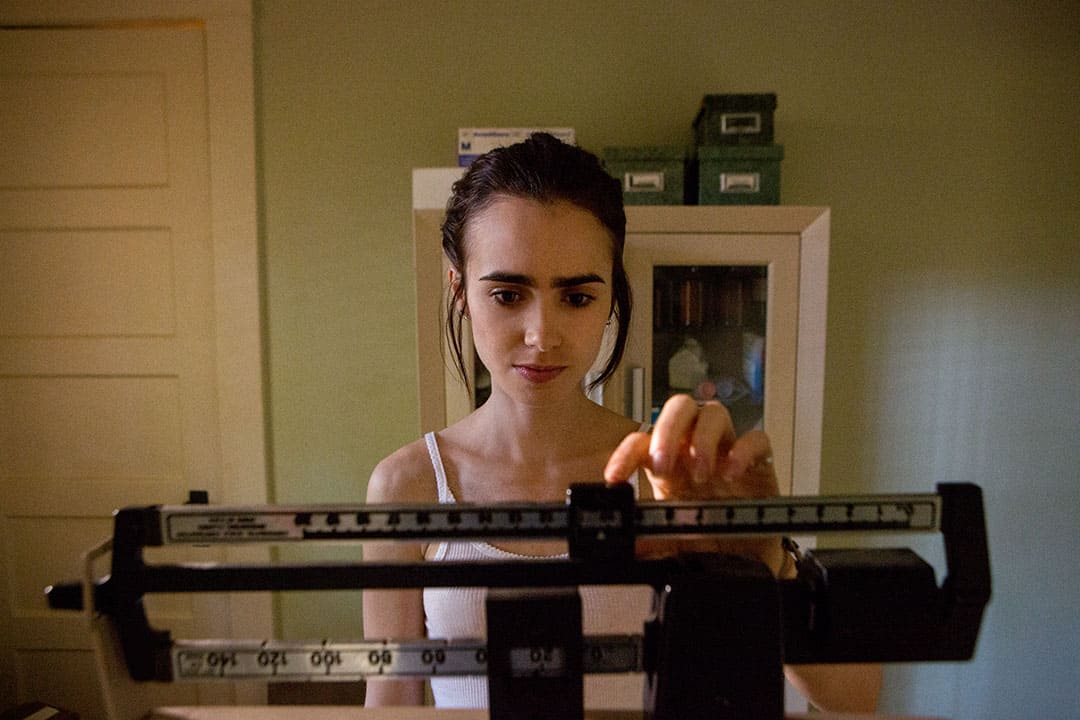Netflix’s original programming appears to be on a mental health kick. Not too long after the hit series 13 Reasons Why became entangled in controversy over its depiction of graphic content, this summer’s feature film release To the Bone has ignited similar debates.
The film follows 20-year-old Ellen, played by Lily Collins, as she struggles with anorexia; there have been claims that the movie could be triggering for viewers vulnerable to depictions of disordered eating, with some going so far as to accuse the film of glamourizing eating disorders.
Director Marti Noxon, who has had personal experience with anorexia, has stated that she intended for the film to spark a wider conversation about body image and eating disorders. “What’s amazing,” she told IndieWire, “is people who’ve been through [disordered eating] know what we’re talking about, and people who haven’t finally say, ‘Oh, I get it.’ That’s what I hope.”
Though Noxon’s compassion is appreciated, if To The Bone’s raison d’être is to transform the way we talk about eating disorders, it sorely misses its mark. Of the numerous problems with the film’s portrayal of disordered eating, the biggest is the simple fact that it does nothing to correct the misconceptions that dominate the popular understanding of these illnesses. Instead, it perpetuates the maddeningly oversimplified image of the emaciated white teenage girl as the archetypal eating disorder patient.
Eating disorders are estimated to affect up to 15 per cent of adolescent females. In Canada, that could translate into roughly 448,000 young women. The rate for adolescent males is roughly three per cent. At the college level in the US, the rate is 16 per cent for trans persons. All ethnicities are affected. By contrast, the prevalence of anorexia nervosa specifically, which serves as the main villain in To the Bone, is estimated by Statistics Canada to be one per cent at most among the general population. Given that anorexia has one of the highest mortality rates of any mental disorder, even one per cent is a disturbing figure.
Unlike the film’s cast of characters, the vast majority of those with easting disorders do not look sick. This is the crucial gap between the wider perception of disordered eating and the reality thereof: even though eating disorders manifest in the body, they wreak the most havoc on the mind. Put differently, you do not have to be thin to have an eating disorder.
While most people are familiar with anorexia and bulimia alone, there are actually several eating disorders listed in the Diagnostic and Statistical Manual of Mental Disorders (DSM). Among these is Other Specified Feeding or Eating Disorder (OSFED). OSFED serves as a catch-all category for ‘partial-syndrome’ cases in which an individual definitely has disturbed eating- or weight-related behaviours but does not meet diagnostic criteria for a ‘full-syndrome’ eating disorder. For instance, one’s body mass index might not be low enough to qualify as diagnosed anorexia nervosa, or they may not purge frequently enough to be bulimic.
From a distance, this system of classification seems to establish two tiers of eating disorders: ‘serious’ and ‘not that serious.’ But recent studies have demonstrated that partial-syndrome disorders carry with them the same level of impairment as their full-syndrome counterparts. When it comes to somebody’s level of internal anguish — how long they spend thinking about food and weight each day, how often they pinch and tug at the fat on their bellies, how intensely it distresses them just to look at their body in a mirror — there is no meaningful distinction between OSFED and disorders like anorexia.
Although estimates of prevalence can vary, one study with a sample size of 496 adolescent females found that 11.5 per cent of adolescent females had experienced OSFED by the time they were 20, while 0.8 per cent had been diagnosed with anorexia. This is not to undercut anorexia’s seriousness — it is certainly a deadly disorder, but fortunately it’s one that is relatively rare.
Given that anorexia is the only diagnosis that requires a significantly low body weight, it’s reasonable to assume that many, if not most, people with eatings disorders might not appear unhealthy to an average observer. What people need to understand about disordered eating is that it is usually invisible and able to masquerade in our weight-obsessed culture as benign dieting or simply ‘healthy eating.’
To the Bone nonetheless focuses on that 0.8 per cent, and in doing so, inadvertently reinforces the idea that a person must be on the verge of death before they can be considered ‘sick’ with an eating disorder. This perception has very real consequences: it blinds those afflicted, their loved ones, and even their doctors to the fact that they have a psychiatric illness.
To the Bone does not get everything wrong. Noxon takes aim at the false idea that eating disorders are born out of vanity, a notion she dismantles through her empathetic and careful telling of Ellen’s story.
But while the film is well-written, well-acted, and darkly funny, it is by no means a game changer.


